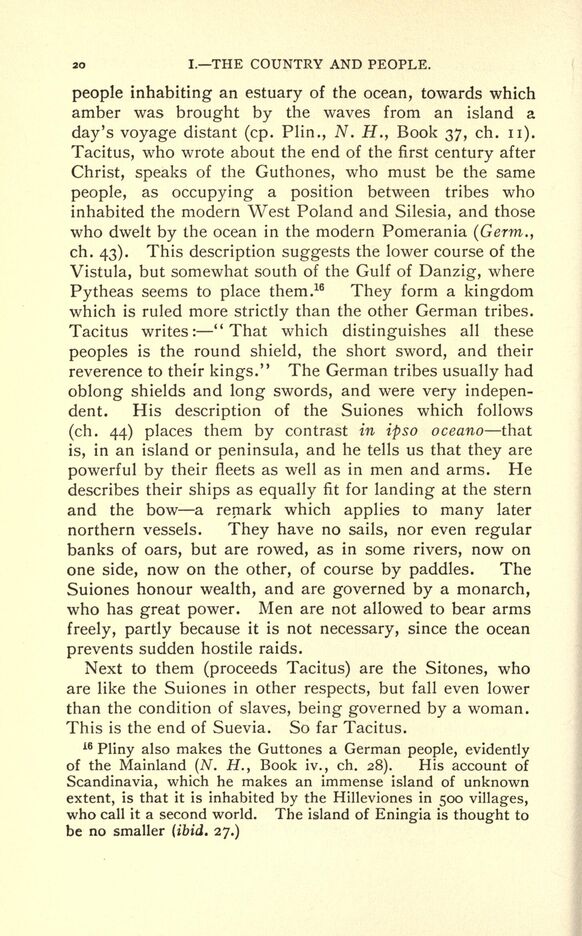
Full resolution (JPEG) - On this page / på denna sida - I. Introductory Lecture.—The Country and its Inhabitants in the Heathen Period up to 1000 A.D. - § 6. Second Period of the Iron Age

<< prev. page << föreg. sida << >> nästa sida >> next page >>
Below is the raw OCR text
from the above scanned image.
Do you see an error? Proofread the page now!
Här nedan syns maskintolkade texten från faksimilbilden ovan.
Ser du något fel? Korrekturläs sidan nu!
This page has never been proofread. / Denna sida har aldrig korrekturlästs.
20 I. THE COUNTRY AND PEOPLE.
people inhabiting an estuary of the ocean, towards which
amber was brought by the waves from an island a
day s voyage distant (cp. Plin., N. H., Book 37, ch. u).
Tacitus, who wrote about the end of the first century after
Christ, speaks of the Guthones, who must be the same
people, as occupying a position between tribes who
inhabited the modern West Poland and Silesia, and those
who dwelt by the ocean in the modern Pomerania (Germ.,
ch. 43). This description suggests the lower course of the
Vistula, but somewhat south of the Gulf of Danzig, where
Pytheas seems to place them.16
They form a kingdom
which is ruled more strictly than the other German tribes.
Tacitus writes:
"
That which distinguishes all these
peoples is the round shield, the short sword, and their
reverence to their kings." The German tribes usually had
oblong shields and long swords, and were very indepen
dent. His description of the Suiones which follows
(ch. 44) places them by contrast in ipso oceano that
is, in an island or peninsula, and he tells us that they are
powerful by their fleets as well as in men and arms. He
describes their ships as equally fit for landing at the stern
and the bow a remark which applies to many later
northern vessels. They have no sails, nor even regular
banks of oars, but are rowed, as in some rivers, now on
one side, now on the other, of course by paddles. The
Suiones honour wealth, and are governed by a monarch,
who has great power. Men are not allowed to bear arms
freely, partly because it is not necessary, since the ocean
prevents sudden hostile raids.
Next to them (proceeds Tacitus) are the Sitones, who
are like the Suiones in other respects, but fall even lower
than the condition of slaves, being governed by a woman.
This is the end of Suevia. So far Tacitus.
16
Pliny also makes the Guttones a German people, evidently
of the Mainland (N. H., Book iv., ch. 28). His account of
Scandinavia, which he makes an immense island of unknown
extent, is that it is inhabited by the Hilleviones in 500 villages,
who call it a second world. The island of Eningia is thought to
be no smaller (ibid. 27.)
<< prev. page << föreg. sida << >> nästa sida >> next page >>